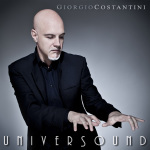Beautiful music. Bravo! Great mood. Great compositions. Just beautiful…
…Your touch of the keys emits a passion like none I have heard in a long time…
…Some of the best moving and inspirational music I have heard this year. Not only will you get airtime on the riverbank, but you have another fan.
Your music is wonderful! Thank you for writing me and sharing your talent with my listeners…
Your music is a perfect fit for our station We have listed you as a core artist.
I’m very impressed with your compositions! very nice!! Ill be very glad that your music play in the station
PianoPianoForte” – RJLannan (cinque stelle – recensione su New Age Reporter) From Rome with Love and Passion Somewhere sandwiched between the music of ambient/electro band Balligomingo and esoteric orchestrator Paul Schwartz is Italian composer Giorgio Costantini and frankly, that’s a fine place to be. There is a singular connection among classical orchestration, movie soundtracks and contemporary instrumental music and Costantini has not only found his way over that bridge, but he has made his own distinctive pathway. His compositions are lush orchestral works with moody scores and distinctive sparking percussion. Adagio , the opening track has a bit of Italian opera flavor, but the repast is replete with present day echoing strings and a modern dance beat. It has an expression of movement and a feeling of new found energy in the bright piano melody. It is there to get the juices flowing and it does. Tutto Amor Perduto or All the Love Lost is an extraordinary experience of Costantini’s lush orchestration with a tinge of Jan Hammer. There is a bit of synthesizer and electronic percussion, but the chill goes on. My absolute favorite track is one called Nero . Brooding, grooving and exquisite. Nero, Rome’s most notorious emperor may b e watching Rome burn or being tutored by Seneca, but he is doing it to an elaborate score with haunting voices, dramatic piano with Giorgio at his best. It is a tale as old as time. I have to admit I had the repeat button on this one for quite a while. Rain , a melancholy piano piece, is pure emotion. A haunting tune that washes away the fears and cleanses the spirit. There is a pitter-patter of solace and just a sprinkle of hope. Oh yeah, it’s sad, but beautiful sad. And for a perfect follow up, Giorgio’s Arcobaleno with its brooding solo piano is the perfect song for my rainy day. Ironically, arcobaleno is Italian for rainbow. How sad that the colors of his rainbow are mottled pastels and not vivid sky brightening stripes, but the color remains ever-present and the mood a bit somber. But don’t you just feel that way sometimes?Giorgio Costantini is a music arranger and composer living in Rome. Although he has performed on tours for the last decade, recently he has turned his considerable talents to being at times a session musician and at other times writing TV and filmscores. Costantini uses the antique classical influences of Satie and Debussy and the more modern inspiration of Michael Nyman and Ryuichi Sakamoto for his musical magic. You can play him for mood music, at a dance club or for intimate rendezvous. Regardless, Giorgio Costantini will provide the perfect musical background for the occasion. Honestly I continue to play this artist for pure enjoyment whenever I am not obliged to listen to something else. If cinematic orchestration is your forte than this recording is highly recommended. |
“PianoPianoForte” – Kathy Parsons (cinque stelle – recensione su Solo Piano Publications) “Pianopianoforte” is a gorgeous collection of piano-based pieces by Italian composer/arranger/pianist Giorgio Costantini. Costantini has toured extensively with Italian and international artists, worked on Italian television, produced an Italian rock band, and also works as a trainer at The Michel Hardy University of Psychology where he creates music for health, meditation, and relaxation. -Rating: Excellent ***** |
“UNIVERSOUND” – HEAT ANDREWS (5/5, recensione su Review You) “Italian musician and composer Giorgio Costantini has been meeting with some musical success in his native country for the last few years, thanks to the proliferation of his music over iTunes and the internet. Having spent time playing in orchestras as well as the recording studio, Costantini’s tastes and abilities lend themselves very well to creating his own style of neoclassical work. Costantini states some of his work is reminiscent of artists like Bach and Chopin as well as modern artists like Tony Banks (keyboardist from Genesis) and Ryuichi Sakamoto (keyboardist from Yellow Magic Orchestra). The comparison to the latter of these musicians is particularly apt, since not only do they have a strong history of performing popular music, but both have recorded classical orchestra pieces as well. This is where Costantini’s album, Universound, finds itself, blending the sounds of classical music’s grandeur with the condensed thrill and structure of popular music. Universound is divided into very distinct song formulas where each song is either performed on solo piano or centered on piano and accompanied by orchestration. Costantini chooses wisely to alternate between these two styles every one or two songs. This format helps greatly in creating a better flow for the album, allowing the pieces to distinguish themselves better and avoid sound-a-likes. Costantini also performed, mixed, and arranged each song himself, so if there’s any problem with the songs, the blame can be laid primarily upon him. Fortunately, Costantini’s talent is very impressive, and is witnessed as early as the first track, “Alba Mundi.” Alba Mundi” begins with a soft piano intro and at thirty seconds in, introduces a simple drum beat and the beginnings of a synthesized string section. As the song continues, the drum fills get heavier, the sound of the strings expand, and the piano playing becomes more intense. Just as the song reaches its fullest, it condenses back down to its piano core and starts to expand again, all within three and a quarter minutes. The next track, “Life” is the other type of song, a slow, piano based classical ballad. Despite these songs lacking the lush sounds of the other style, there’s a legitimate sense of intimacy as Constantini plays emotionally throughout, hether it be the quiet passages where each note feels emotionally weighted, or when his hands are quickly playing through scales. Of the more symphonic instrumentals, “The Emperor” is particularly riveting. As in “Alba Mundi,” the driving drum fills do wonders in adding a sense of urgency to the music and the vocal choir effects are chilling. During the sections when the backing instrumentation is subdued, Constantini’s piano playing chimes through with exceptional soloing that demonstrates his talent for playing as much as it does his talent for composition. If there’s anything negative about these tracks, it’s that their grand arrangements sometimes overshadow the stripped down, solo piano pieces. But, many of these solo instrumentals have a unique atmosphere as well. “Jellyfish Ballet” has about as much atmosphere as a three minute piece could possibly allow. The melody that permeates the song is rich and just dark enough to simulate the ocean depths, while being simultaneously uptempo enough to convey the majestic movements of jellyfish dancing in a current. In this respect, the earlier track, “Oceano” feels like a companion piece. The tone of both is quite similar though the former feels more elegant and the latter more bleak, like the ocean itself. The simplicity of pieces such as these convey emotion in ways that a fuller sound can not do, and Constantini recognizes this ability in his music Gio” is another piece, though more lighthearted than “Jellyfish Ballet,” that has a simple melody which conveys more in its single piano structure than it could with more. Constantini establishes the melodic theme from the beginning and continues to revisit it as the piece continues. As ornate as the sections are that follow, the music never strays too far from its base as to sound unfamiliar. Another fine example of this is “Tutto in una Notte” which begins and ends with the same notes, yet goes through a tremendous build into a lifting orchestral section during it’s middle section. This feature of Costantini’s music is perhaps what makes it so accessible and enjoyable Universound is an incredibly majestic album of instrumentals that helps define classical music in a modern sense. Giorgio Costantini has studied the works of some of the best composers in classical and popular history, and what’s more, has the ability to do them justice with his exceptional abilities as a musician, and composer. The album title is a wonderful apt name, as it’s this kind of music that can have a degree of universal appeal with its fascinating blending of influences, and exceptional performances. Review by Heath Andrews Rating: 5 stars (out of 5) ***** |
- Tesla (432 Hz version) // album: "The Dreamer"
- Life (432 Hz version) // album: "Universound"
- Alba Mundi // album: "Universound"
- Perdutamente // album: "Universound"
- The Emperor – 432 Hz version // Giorgio Costantini - Universound - 432 Hz
- Elegia // Giorgio Costantini - PianoPianoForte
- Tutto l’amor perduto // Giorgio Costantini - PianoPianoForte






























